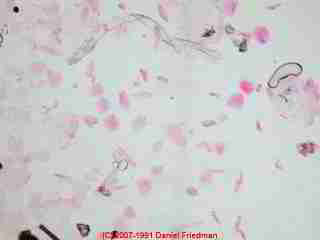 Morgellons Disease or Morgellon's Syndrome
Morgellons Disease or Morgellon's Syndrome
- POST a QUESTION or COMMENT about Morgellon's Disease or Morgellon's Syndrome and complaints about unidentified fibers in the indoor environment and in or on people's skin
This article describes Morgellon's Syndrome, a collection of complaints that people believe are traced to unidentified fibers or "bugs" on or in skin, secretions, and their environment.
We include descriptions of the complaints, case histories, and references to additional details about the different types of particles commonly found in the indoor environment.
We include authoritative citations and references to relevant medical journal articles and similar expert sources. Our page top photograph shows a lab photo of ordinary human skin cells, along with some animal dander, fabric fibers stained with acid fuchsin. There are no unusual fibers, bugs, nor other anomalies in this example.
InspectAPedia tolerates no conflicts of interest. We have no relationship with advertisers, products, or services discussed at this website.
Morgellon's Disease or Morgellon's Syndrome: health complaints believed to originate in fibers, skin irritation, lesions
What is Morgellon's syndrome or Morgellon's disease?
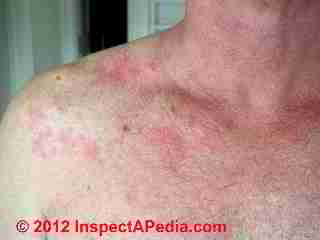 Our photo of an acute skin rash (left) provided by a client was diagnosed as contact dermatitis, not Morgellon's Syndrome.
Our photo of an acute skin rash (left) provided by a client was diagnosed as contact dermatitis, not Morgellon's Syndrome.
Discussed here: Mayo Clinic and expert physician provide authoritative comments on Morgellon's Syndrome and psychocutaneous disease. List of Common Symptoms & Complaints that People Associate With Morgellon's Syndrome.
Technical Notes about the contents of house dust. How we compare & identify fiberglass fragments & fabric fibers. Fiberglass Insulation Dust Exposure & Skin Irritation. Lab Experience With the Presence or Absence of Fibers in Skin Samples.
According to the Mayo Clinic Staff,
Morgellons disease is a mysterious skin disorder characterized by disfiguring sores and crawling sensations on and under the skin. Although Morgellons disease isn't widely recognized as a medical diagnosis, experts from the Centers for Disease Control and Prevention (CDC) are investigating reports of the condition, which they refer to as unexplained dermopathy.
... Morgellons disease shares characteristics with various recognized conditions, including Lyme disease, liver or kidney disease, schizophrenia, drug or alcohol abuse, and a mental illness involving false beliefs about infestation by parasites (delusional parasitosis - Mayo Clinic [3]
Koblenze r[5] has written extensively about psychocutaneous disease, and has described the history and uniqueness of Morgellon's Syndrome named by Sir Thomas Browne in 1674:
Less well understood are other sensations that patients may describe to us, such as crawling, biting, stinging, pricking, burning, shooting, and so forth. These sensations may be focal or generalized, and while some patients may present to us with no visible change in the skin—those with brachioradial pruritus, for example—others, reporting that the discomfort is relieved only by picking, squeezing, or pulling hair, present with neurotic excoriations, prurigo nodularis, or trichotillomania.
A separate group of patients are those unfortunate few who have an inherent need to ‘‘know’’ and to understand what is going on with their skin.
These patients, made very anxious by the vacuum in their knowledge, and perhaps also by their inability to attain relief from professionals will, with great ingenuity, ‘‘create’’ a ‘‘cause’’ for their symptoms, which makes logical sense to them, and with which they can be comfortable.
Because of the nature of the sensation, many of these patients believe themselves to have an infection or infestation, and we are of course all familiar with the syndrome of delusions of parasitosis, or Ekbom’s disease, as is described in the two letters.
What is remarkable in Sir Thomas Browne’s description, in the literature references over the past 75 years, and in the complaints of our patients today, is the extraordinary similarities that they all describe—in the quality of the sensory changes experienced, in the level of the patient’s distress, in the various and ingenious interpretations of what may be happening in the skin, and in the ongoing and desperate search for relief.
The patients are virtual carbon copies, one of the other.
The clinical picture is unmistakable. The patient is intensely anxious, is obsessively focused on his or her symptoms, brings ‘‘specimens’’ of the offending agent, or agents, and is unshakable in his or her belief as to the cause.
Usually there will be a logical explanation of exactly how the infection or infestation was contracted, and the patient will have resorted to the most extreme measures both to eradicate it and to prevent contagion. [5]
List of Common Symptoms & Complaints that People Associate With Morgellon's Syndrome
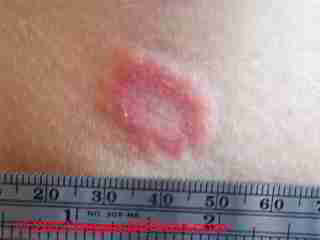
We have received quite a few complaints from people who trace a variety of irritations and health concerns to unidentified fibers or dust in their environment and who are confident that that material is causing in turn a variety of unusual health and indoor air quality complaints.
Our photo of a skin lesion (shown at left) is not associated with Morgellon's Syndrome and in fact was traced to an acute exposure to airborne Stachybotrys chartarum.
People who are suffering from Morgellon's Syndrome-like complaints (or for that matter any other medical complaint) should not hesitate to seek expert advice, starting with their own physician who knows their medical history &c., and pursuing their complaint with experts in appropriate fields as needed.
Most often your own doctor can give the best advice on seeking treatment or further consultation with suitable experts.
Typical Moregellons'-like complaints we have heard from building inspection clients and readers are summarized below, followed by some case histories and reader comments that may be helpful.
- I have unexplained itching in various areas
- There are fibers in my nasal secretions
- There are fibers coming out of my skin, I see blue, black or red fibers and granules under my skin and coming out of it
- There are fibers entering my skin
- I keep finding fibers in scalp particles or scrapings
- I have spontaneous skin lesions or skin eruptions
- I had the bugs in my skin; or I feel a sensation of crawling or biting under my skin
- I had a fungus in my skin that shows up as fibers
- I suffer from fatigue, memory loss, obsessive compulsive disorder, impaired brain functioning, depression and it is coming from these skin problems
Technical Notes about the Usual Contents of House Dust
The common constituents of house dust are fabric fibers and skin cells, with a lower proportion of incidental pollen, mold, dust mite fecals, and where pets are or have been present, animal dander and hair.
Other common but lower frequency particles include starch granules, soil particles, and depending on the building and its mechanicals, soot.
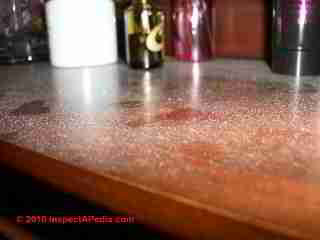
Above ) a client photo shows a heavy and rapid dust accumulation on building surfaces.
Below our lab photo shows that the prime contents of the dust were fabric fibers and starch granules, not building insulation in this case. - DF & WW 6/2010
It is also common to find some fiberglass particles in most buildings, usually traced to building insulation. Carpets in buildings are often a significant source of indoor dust (fabric fibers) as may be other fabrics in environments that use heavy curtains and lots of upholstered furniture.
Readers should note that the level of indoor dust varies widely in buildings building environments.
Comparing fiberglass and fabric fibers
Our lab photos (below) compare fiberglass fragments with fabric fibers.
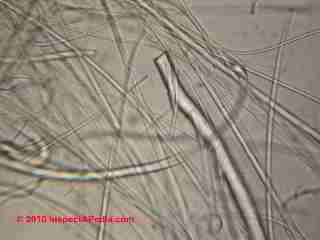
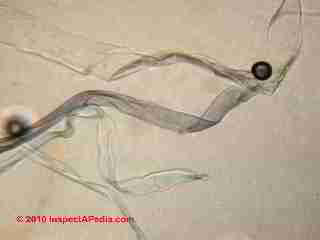
Fiberglass Insulation Dust Exposure & Skin Irritation
OPINION-DF: various indoor environmental contaminants may in some cases be associated with skin irritation complaints, including exposure of insulation workers to high levels of contact with fiberglass insulation. In our experience skin irritation from fiberglass insulation generally diminishes rapidly and stops within 24-48 hours of bathing and thorough washing of dusty clothing.
Where we most experience as well as receive complaints of skin irritation traced to fiberglass exposure it is by people installing, demolishing, or stomping around on fiberglass building insulation, particularly in older buildings where foot traffic (in an attic without complete flooring for example) or other activities have damaged the insulation, increasing the proportion of small fiberglass fragments.
See
FIBERGLASS PARTICLE CONTAMINATION TEST
Lab Experience With the Presence or Absence of Fibers in Skin Samples
In the indoor environmental samples and even some tape samples of skin surfaces where readers or clients have expressed concern or confidence that unidentified fibers are both cause and symptom, using light microscopy and polarized light microscopy to 1200x magnification we have never found identifiable fibers other than incidental house or clothing dust and fabric fibers at normal levels.
In other words, a careful cross-sectional examination of superficial skin samples in using transmitted light microscopy for the samples we have studied showed without exception that fibers in the sample were adhered to the skin's exposed or outer surface; they were not found growing in or through the skin nor originating from inside the body.
Watch out: it is common (and normal) for to find in lab samples collected of from human skin surfaces some fibers such as those coming from from carpeting, clothing, etc., and on occasion other types of fibers, both natural and manmade both on skin and "apparently" embedded in skin samples.
This is particularly true if a surface sample is collected from a sore or lesion as such skin surfaces are typically more sticky than other skin areas.
Such samples can be collected from individuals who have no Morgellon's syndrome complaint as well as people who do. In some cases that we have researched we could identify the probable fiber source by careful comparison of sample fibers to fiber sources in the building such as carpeting or furnishings.
Readers should therefore view with caution photographs published at some websites purporting to provide hard evidence that Morgellon's sufferers indeed have unusual or pathogenic fibers erupting from their skin.
The suggestion of our limited observations is that sufferers from Morgellon's Disease should consult carefully with their physician and if the physician agrees that it is appropriate, ask for a referral to a specialist in environmental medicine.
Notice: the authors & reviewers are not physicians and do not offer medical diagnostic advice. Here we describe common observations & complaints described by some who might be described as suffering from Morgellon's Syndrome. (Also research delusional parasitosis, Ekbom's syndrome)
We have field and laboratory experience in investigation of the indoor environment and building related health complaints and we report here on the experience of a wide readership base, some of whom report undiagnosed skin irritations that the sufferers are confident are traced to unidentified fibers in their environment. Technical review, critique, comments, content suggestions are invited. Please use the Comments Box found at the end of this article. - DF
Itching Conditions in Humans - Supporting Research
For skin-related itch and fiber complaints see your doctor.
In February 2014 The New York Times reported on research into conditions that cause itching using an M.R.I. Scanner, giving new insight into why people itch and why scratching relieves itching. Of interest to people suffering from skin complaints described as itching and diagnosed as Morgellon's disease, a subject person of the Times article was noted to suffer from having been mis-diagnosed as having a mental issue treated by antidepressants when in fact the individual had a rare disease causing itching.
- [15] Arnold LM. Psychocutaneous disorders. In: Sadock BJ, Sadock
VA, editors. Kaplan and Sadock’s comprehensive textbook of
psychiatry. 7th ed. Philadelphia: Lippincott, Williams and Wilkins; 2000. pp. 1823-7. - Bautista, Diana M., Sarah R. Wilson, and Mark A. Hoon. "Why we scratch an itch: the molecules, cells and circuits of itch." Nature neuroscience 17, no. 2 (2014): 175-182.
- Bautista, Diana M., Maurizio Pellegrino, and Makoto Tsunozaki. "TRPA1: A gatekeeper for Inflammation." Annual Review of Physiology 75 (2013): 181-200.
- Chiang, Herbert C., Victor Huang, and Lynn A. Cornelius. "Cancer and itch." In Seminars in cutaneous medicine and surgery, vol. 30, no. 2, pp. 107-112. WB Saunders, 2011.
[Dr. Lynn Cornelius, an author in this article, is cited in the NY Times Article listed below.] - Denise Grady, "Itching: More Than Skin Deep, With new science, a new look at a condition that causes lasting misery for many", The New York Times, 18 February 2014, P. D1, D5.
- Downs, Anthony MR, and Cameron TC Kennedy. "Successful treatment of intractable palmoplantar pruritus with ondansetron." Archives of dermatology 134, no. 8 (1998): 925-926.
- [4] Friedman, Daniel, P.I. "Onsite Mold Investigation including sick individuals, sick pets, skin rashes, death of one pet", Daniel Friedman, 6/1/2004, private investigation report, lab work, site photos, on file.
- [9] Greaves MW, Khalifa N. Itch: more than skin deep. Int Arch Allergy Immunol 2004;135:166-72.
- [5] Koblenzer CS. The challenge of Morgellons disease. J Am Acad Dermatol 2006: 55: 920–922., retrieved 8/10/12, source: http://www.physics.smu.edu/scalise/P3333sp08/MorgellonsCommentary.pdf [copy on file as [MorgellonsCommentary.pdf]
Also see- Koblenzer CS. Cutaneous manifestations of psychiatric disease that commonly present to the dermatologist – diagnosis and treatment. Int J Psychiatry Med 1992: 22: 47–63.
- Gupta MA, Gupta AK, Ellis CN, Koblenzer CS. Psychiatric evaluation of the dermatology patient. Dermatol Clin 2005: 23: 591–599
- Koblenzer CS. Neurotic excoriations and dermatitis artefacta. Dermatol Clin 1996: 14: 447–455.
NOTE: Citations [6] - [15] below are selected from Koblenzer [5] above.
- [6] Koblenzer CS. Psychotropic drugs in dermatology. In: James
WD, Cockerell CJ, Dzubow LM, Paller AS, Yancey KB, editors.
Advances in dermatology (vol 15). St Louis: Mosby, Inc; 2000. pp. 183-201. - [7] Koblenzer CS. Psychocutaneous disease. New York: Grune and Stratton, Inc; 1987. pp. 108-30.
- [8] Koblenzer CS. Neurotic excoriations and dermatitis artefacta. Dermatol Clin 1996;14:447-55.
- [3] Mayo Clinic, "Morgellons disease: managing a mysterious skin condition", The Mayo Clinic, web search 02/27/2011, original source: http://www.mayoclinic.com/health/morgellons-disease/sn00043
- [11] Schmeltz M, Handwerker HO. Neurophysiologic basis of itch. In: Yosipovitch G, Greaves MW, Fleischer AB, McGlone F, editors. Itch: basic mechanisms and therapy. New York: Marcel Dekker, Inc; 2004. pp. 5-12.
- [13] Musalek M. Delusional parasitosis. In: Koo JYM, Lee CS, editors.
Psychocutaneous medicine. New York: Marcel Dekker, Inc;
2002. pp. 143-52. - [14] Munro A. Delusional disorder. Cambridge: Cambridge University Press; 1999. pp. 78-93.
- [12] Stander S, Steinhoff M, Luger TA. Pathophysiology of pruritus.
In: Bieber T, Leung DYM, editors. Atopic dermatitis. New York:
Marcel Dekker, Inc; 2002. pp. 183-216. - The, Lydia, Sarah Wilson, Katherine Beattie, Maurizio Pellegrino, Lyn Batia, George Katibah, Daniel Estandian, and Diana Bautista. "A NEW SIGNALING PATHWAY BETWEEN EPITHELIAL CELLS AND NEURONS TRIGGERS ITCH VIA THE ATOPIC DERMATITIS CYTOKINE TSLP." In ACTA DERMATO-VENEREOLOGICA, vol. 93, no. 5, pp. 606-606. 2013.
- [10] Ward JR, Bernhard JD. Willan’s itch and other causes of pruritus in the elderly. Int J Dermatol 2005;44:267-73.
- Wilson, Sarah R., Kristin A. Gerhold, Amber Bifolck-Fisher, Qin Liu, Kush N. Patel, Xinzhong Dong, and Diana M. Bautista. "TRPA1 is required for histamine-independent, Mas-related G protein-coupled receptor-mediated itch." Nature neuroscience 14, no. 5 (2011): 595-602.
[Dr. Diana Bautista, an author in the article above is cited in the New York Times article also cited earlier] - Wilson, Sarah R., Aislyn M. Nelson, Lyn Batia, Takeshi Morita, Daniel Estandian, David M. Owens, Ellen A. Lumpkin, and Diana M. Bautista. "The ion channel TRPA1 is required for chronic itch." The Journal of Neuroscience 33, no. 22 (2013): 9283-9294.
- Wilson, Sarah, and Diana Bautista. "Itching for relief." Nature neuroscience 16, no. 7 (2013): 775-777.
- [16] Yosipovitch, Gil, Lena S Samuel, NEUROPATHIC AND PSYCHOGENIC ITCH [PDF] Dermatologic Therapy Volume 21, Issue 1, pages 32–41, January 2008, retrieved 8/10/12, source: http://onlinelibrary.wiley.com/doi/10.1111/j.1529-8019.2008.00167.x/full
Abstract:
Neuropathic and psychogenic itch are two entities that have not been well studied.
Neuropathic itch is related to pathology located at any point along the afferent pathway of the nervous system. It could be related to damage to the peripheral nervous system, such as in postherpetic neuropathy, brachioradial pruritus, notalgia paresthetica, and in central nervous system damage as a result of spinal cord tumors and demyelinization diseases such as multiple sclerosis. It has many clinical features similar to neuropathic pain.
Patients complain of itch, which coincides with burning sensation, aching, and stinging.
Psychogenic itch is related to psychologic abnormalities e.g., itch in obsessive compulsive disorders, depression, and delusions of parasitosis. Although no controlled studies have been conducted for treatment of neuropathic and psychogenic itch, medications that are part of the treatment armentarium for neuropathic pain, depression, and anxiety seem to be effective.
Conclusion: Neuropathic and psychogenic itches remain challenging diagnostic and therapeutic conditions.
They require in many cases the help of neurologist, pain specialist, and psychiatrists. Future studies in this field and in particular therapeutic controlled trials will enable us to provide better treatment to these tormenting types of itch. [copy on file as Yosiipovitch_Itch.pdf] - Zhao, Zhong-Qiu, Fu-Quan Huo, Joseph Jeffry, Lori Hampton, Shadmehr Demehri, Seungil Kim, Xian-Yu Liu et al. "Chronic itch development in sensory neurons requires BRAF signaling pathways." The Journal of clinical investigation 123, no. 11 (2013): 4769.
Reader Comments, Questions & Answers About The Article Above
Below you will find questions and answers previously posted on this page at its page bottom reader comment box.
Reader Q&A - also see RECOMMENDED ARTICLES & FAQs
On 2022-05-13 by Inspectapedia Com Moderator - unidentified black and brown spots on skin
@Pee,
Sorry but we can't say anything about those black specs you're wiping off of your skin. But if they're charred remains of hair or skin flakes, the result of applying a lighter flame to your skin, it sounds as if what you're doing may be making the irritation worse.
Your skin does look irritated, but, then, we're not doctors here.
What's most-important is for you to find a doctor whom you trust, perhaps a dermatologist, and then listen to her advice.
On 2022-05-13 by Pee
This is what I wipe off my skin… sometimes they are brown, sometimes they are black. :-(
On 2022-05-13 by Pee
Hi,
I am suffering from an infestation of a parasite or mite or fleas, I have no idea what it is, they jump, they attach themselves to the hair on my skin, I just shaved my head, but they for some reason get the hair on my body stand straight and then they attach.
I’m always wiping my skin, sometimes I use a lighter to chase them off and they literally spark when burnt… I need help, I. Am exhausted. Thank you
On 2021-11-05 by Inspectapedia Com Moderator
@John Forest,
Thank you for the photo.
Do keep in mind that it is common and normal to find fabric and similar fibers in the environment, in house dust, and thus on one's skin.
On 2021-11-05 by John Forest
@Tiffany N., My thoughts are, having had this struggle for over 15 years and many Dr's., the conclusions are decided upon because, not enough time is spent on diagnosis. I can prove the Existance of this painful
The issue I have, recently diagnosed with crinic Lyme and Morgellons disease, is definitely not fiberglass, I have taken many samples and videos to show this painful monster.. So fiberglass, mmmm not so much
Oh and i did fiberglass work on vehicles and in construction.
On 2021-04-30 by danjoefriedman (mod) - how worried should you be about fiberglass
@Tiffany N.,
Bottom line: in general you don't’ need to worry unless fiberglass insulation in your building has been mechanically damaged and then blown or spread throughout the building enough to create high levels of dust and particles of many varied sizes or lengths OR if your personal physician tells you that by medical examination she has found a health concern for you that would be either caused by or aggravated by various levels of indoor dust.
Discussion:
Large fiberglass fibres and fragments are found in building dust.
At incidental levels those are normal and harmless. Only if a dust sample finds that fiberglass particles dominate the sample or are present at unusual levels would further investigation be justified.
What about very small fiberglass particle hazards?
In our own lab I first noticed that very careful examination of dust samples could find very hard-to-spot very small fiberglass particles - even down in the 1 micron range. Unless the microscopist uses the right sample slide mounting media with the right refractive index and unless she works diligently at the microscope those tiny particles might be missed - leading researchers to think only big fiberglass particles are found.
I thought - years ago - that those ultra-small fiberglass fragments would be a carcinogenic hazard.
That's apparently not the case: enough expert research has been done to weigh in to assert that those ultra-small particles are absorbed and have (by most accounts) not translated into the risk that concerned researchers.
You will find numerous citations of research articles and sources in all of the articles in this series. Frankly it would be foolish and baseless to even claim to distrust so many independent researchers with such wide and usually deep credentials.
The most common and best supported evidence from trusted sources we cite is that the principal hazard of fiberglass dust exposure is that of an irritant; to skin and possibly a respiratory irritant.
What about cleaning up fiberglass dust?
IF by some work on a building or by damaged ductwork or damaged insulation, it’s appropriate to clean up fiberglass-dust, normal HEPA vacuuming and damp wiping will be effective.
It is unnecessary and impossible to set a goal of reaching zero fiberglass particles in a building - we can’t get ANY particle to a level of absolute zero without such heroic and expensive measures as to be prohibitive; furthermore there is no medical justification for such measures.
What about cleaning fiberglass-contaminate clothing?
Normal laundering or dry-cleaning, possibly with repeat cycles to be thorough, is effective at removing most fiberglass debris from most clothing. There may be unusual cases of extreme levels of contamination, say from a jobsite, that would suggest it’s less expensive to throw out a shirt or pair of pants than to spend a large sum cleaning them.
What about skin lesions and fibres erupting from one’s skin?
There is no scientific evidence that humans have fiberglass inside their body and erupting out through their skin.
I have examined various samples of building dust, building air, surface samples of fibres on fabrics and clothing, even samples of what clients were sure was fiberglass coming out of their skin. While, as I’ve noted, it’s normal to find some fiberglass in building dust (along many other dust particles) and even some on clothing, not one of the skin samples I’ve examined supported an in-body fiberglass eruption belief.
Nevertheless some people can become absolutely convinced of and unfortunately misled by this belief - in a series of maladies discussed under the umbrella of Morgellon’s syndrome described on this page.
In my own experience, if a spot on my skin bothers me and I scratch at it, I can create a worse spot of irritation, even lesion that can then be confusing medically: did a serious underlying medical condition cause the lesion or did I cause it simply by scratching at a medically-insignificant itch?
In any event people’s suffering is real and the medical effects of anxiety and suffering take a toll on anyone.
BOTTOM LINE: it is very important for people who are suffering from any medical complaint, including skin complaints, to find a doctor whom they trust, consult the doctor, and then to listen to and follow the doctor’s advice.
I'll repeat what I said to an earlier reader:
It is important to use scientific data and research in addressing and solving a problem and not spread false information with no basis in fact.
On 2021-04-30 by Tiffany N.
@ericka, may god bless you! You are on point, chic! People do not stick there selves out there to help someone like they would themselves. It’s a greedy world! I refuse to be one of those people! I will not stop until I make a difference or god takes me before I can.
If you “work in a lab” that tests fiberglass dust, all you got to do is experiment with it- cut up some old insulation, make it smaller than 0.3 microns in size and see what happens. But be honest. If the person looking under the microscope isn’t you, then don’t tell them what you did and see what they say it is.
Is that practical? No. If there’s a will there’s a way! Don’t give up....God is real and it may take a lot of effort, but with him, we can do anything!!!
On 2021-04-30 by Tiffany N.
What’s awful is how everything that the “sufferers” of “morgellons syndrome/disease” explain as symptoms in confidence, is exactly what sufferers of fiberglass dust explain as symptoms when they are unaware that it’s fiberglass dust. To make matters worse, they get pushed in a corner with every professional out there telling the family member(s), who then have to “take care” of them and make sure they go to a “psychiatric ward” etc. For “help,” that the help they need is due to “psychiatrically” issues.
What happens then? The patient is left thinking they are “crazy” with a home left with fiberglass dust contamination and just have to “deal with it” for however long until it’s properly identified and cleaned. To make matters even worse, because fiberglass dust has a static charge, it is extremely difficult to get out of hair and sticks to everything (following the sufferers everywhere they go), they can’t go anywhere without it being on them and everything around them etc.
Also, we know that most people cannot feel fiberglass dust so it’s only the people that can, experiencing these issues. Why is all of this happening to so many people, you may ask? Because fiberglass dust that is smaller than 0.3 microns in size, cannot be detected as fiberglass dust....It is always detected as anything other than.
When fiberglass insulation has been “pulverized” in any form (ex. If it is old and was to have “leaked” onto some boards and the boards later ran through any type of machinery...It would then spew everywhere and it’s very hard to see, extremely airborne and can travel to pretty far distances quickly, and has a static charge. Also, if there is high traffic (as in being walked on quite a bit), unknowingly), it then becomes much finer-smaller than 0.3 microns in size and it so much harder to detect.
** my question: why do professionals or anyone else that knows this is very likely to happen, act like it’s not? Is it because they don’t know how to “prove” it is fiberglass dust but “proving” someone’s mental stability is “pulverized” is much easier and more common? It’s simply horrible that this world is so.....Greedy (in a since) and selfish.
If something makes you “look or seem” weird, people will go to any measure to uphold their reputation...Even if it makes someone else’s life a living hell. These kind of people are not christians. Now let’s see if I get a response.
*for the record, I mean no disrespect to anyone...I merely hope to find someone who is in an authoritative position (like the person who is behind this thread giving advice) to dig deep into his/her heart to “make a difference.” please, don’t just “stick with the crowd.” imagine if this was to happen to you or a loving family member. May god bless you!
You and I both know, doctors are not very educated in the field of “fiberglass” - especially when there is very little information for them to get educated on/with. Sir, with all due respect, in the event that this was to happen to you or your child, you would be praying for god to help people believe you- even if you never believed in god before! ....You never know, god may allow it to happen to you simply so that he can get to your heart.
What is it they say...”you know not until it happens to you.”
On 2021-04-06 by danjoefriedman (mod) - worried about fiberglass exposure
@Ericka, It is important to use scientific data and research in addressing and solving a problem and not spread false information with no basis in fact.
I appreciate that this topic and make you and others quite nervous. But I will assure you that in almost 50 years of environmental testing and sampling, including processing an hour on forensic lab skin surface samples from people who are sure the glass was emerging from their bodies, we have never once found that to be the case.
I agree that fiberglass fragments and dust are an irritant, but if you are suffering persistent skin irritation in the right place to start is with your doctor.
It would be unfortunate for someone to face the cost and trouble of moving to a new home based on an incorrect assumption or incomplete information about actual hazards (mold, chemical contaminants, allergens, other more-common problem) in the place where they are living.
I would add that using scholarly-research sources (Google Scholar is an easy place to start), we have not found reports that anybody is experimenting on people in their homes by fiberglass contaminants.
Please share your worries with a medical doctor who knows you and whom you trust.
On 2021-04-06 by Ericka
Fiberglass particles will gravitate towards lint. Some people are allergic to the fiberglass, others are not. Fiberglass exposure will cause you to itch...if you are allergic. The fibers go up your nose when inhaled. When large quanities are inhaled or absorbed through the skin...they surface & exit the skin.
They want to call it Morgellens or whatever.....To me that sounds like some tuskegee airmem type deal.....If your skin is putting out glass....Trust your git move. Many cities are being experimented on......You may be in one!!! Trust your gut....
On 2018-12-16 by Ronald Dodge
I used a cheap polyester rope , made in China, for a clothes line. The fibers in the rope , transferred from the rope too my clothes and linen, and then transferred from my clothes and linen too my skin. I have been dealing with this infestation for nine years. Maybe you are looking in the wrong place, for your answers, to Morgellons syndrome.
On 2018-04-12 by danjoefriedman (mod)
Trust your doctors;
Confirm by physical test samples and lab analysis what is or is not on your skin.
On 2018-04-12 by Teresa Isle
What if you have what appears to be fiberglass in your skin, but no one else in your home has it? I also have these black, what appears to be little wood pieces that get in my skin, that I believe are another form of fiberglass, and my doctor thinks I’m delusional and a dermatologist I saw thinks I have a sleeping disorder. What do I do then?
Question: I have small organisms coming out from my body and hair - like spores.
Hi my name is ... the reason I’m sending this pictures it’s because I don’t know to who else ask for help. I’m going through hell I don’t now what it’s happening to me this it’s the 3rd time on my life that this happens.
I ave been searching for something similar to what it’s happening to me to get an answer and I find that his webpage and reviewing the pictures I think I find something that it looks similar but I maybe wrong I went to the doctor and he didn’t even took a look of my scalp or my hair or my skin. He came to the deduction that I have lice but you can see the pictures and I had have lice when I was little and I know this is not lice.
He took a picture of my face and he send it to the dermatologist next day I receive a phone call from the clinic with the answer from the dermatologist saying that I maybe have dandruff.
This it can’t be see with the naked eye you have to use something like a microscope I download an application that it gave me the chance to take this pictures.
This it’s taking my life away i can’t cook anymore the feeling that something it’s getting on my clothes and then it goes up to my hair and scalp it’s stronger at the kitchen and in the bathroom I have seen like small organisms that are coming out from my body and hair released like spores.
The 3 times this happened i had mold at the place I was living at.
I can’t go with this anymore I can’t even touch my hair.
 I even told my husband if I don’t get help I’m going bold. I don’t know if that will help but it’s horrible what I’m going through.
I even told my husband if I don’t get help I’m going bold. I don’t know if that will help but it’s horrible what I’m going through.
Please help me. - anonymous by private email 2021/11/14
Moderator reply: find a doctor who you trust, consult your doctor, and listen to her advice.
You certainly have our sympathy, we certainly believe that your suffering is real, and I imagine that you are frightened by your concerns as well. I understand and respect those feelings.
I don't completely understand the evidence on which your opinions have been based, but in my experience, your skin and scalp particle complaint and health worries are not something that can be properly diagnosed by photos and email though I'll certainly take a look.
Watch out: Unless you're a trained environmental or medical expert, you shouldn't assume that the particles that you are looking at or have photographed are the important ones having to do with your health concern.
Please take my best and respectful advice, which is that you should not imagine that you can get reliable thorough diagnostic and prescriptive help about a serious environmental or health concern from simply a web page or stranger by email.
You need to find a doctor who you trust, consult your doctor, and listen to her advice.
Reader follow-up: nobody wants to believe me or at least to do a test of my scalp
Hello thank you for your fast response. I understand what you are telling me but nobody wants to believe me or at least to do a test of my scalp. I seriously don’t know what else to do or to who ask for help.
I have already saw 2 doctors but they don’t listen to what I’m feeling and they don’t even check the pictures or the videos.
I ask for them to give me a reference to see a dermatologist but since they cannot see it for them it’s like I don’t have a problem.
What i think it’s that if you can see it that doesn’t mean that it doesn’t exist.
This picture are from my face as you can see close to my eye, my cheeks and my chin. I have videos too the last videos just freak me out and I’m scared because I have never see or knew about something like this in a human being.
I also took picture from the kitchen and under the cabinets above the sink it looks exactly the same as my face.
I just ask for an advice of what else I can do since the doctors don’t help me.
All I can say it’s I don’t think this is normal. I start feeling weak and Im getting dizzy and I’m getting nauseous too.
Moderator reply: consult a suitable medical expert, not a microscope
 With sympathy and respect, please understand that everyone has bits of debris, house dust, lint, skin flakes and other particles on their skin. The presence of those particles is normal and it is not itself a sign of a disease or illness.
With sympathy and respect, please understand that everyone has bits of debris, house dust, lint, skin flakes and other particles on their skin. The presence of those particles is normal and it is not itself a sign of a disease or illness.
Of course you may have a skin ailment that a dermatologist may be able to treat, but there is not one whit of authoritative, expert, scholarly research that supports the extrusion of microscopic nor harmful particles coming out of a persons body and up through their skin to be collected and used to diagnose a skin ailment. Often these worries and skin irritations are traced to more-common skin complaints combined with stress such as puritis.
None of your photographs that I have seen show any useful diagnostic meaning whatsoever. None of them is properly focused, scaled, documented or even made if the correct light exposure.
While it is certainly the case that anyone can put a small particle on a slide and then put the slide under a microscope and try to look at it, those results are not normally useful.
Warning about amateur microscopy
Please understand that my warning below is not out of any intent to suggest that you need to consult a costly expert microscopist. In fact it's not likely that such skin sampling is justified, nor useful, nor diagnostic for the complaint as you describe it.
Watch out: To prepare and analyze microscopic biological or other small particle samples requires training in microscopy, forensic microscopy, microchemistry, slide preparation, mounting chemicals, and optics.
You're not trained in forensic nor medical microscopy.
We don't know what we don't know. That's what can lead us astray. We don't even know that we don't know it.
Those are reasons why your doctors don't feel that the photographs that you are taking of your skin are useful diagnostic tools.
None of this means that you may not have real health or psychological stresses that need attention. The best advice I can give you is what I said before.
One would expect a dermatologist or similar expert to examine you carefully and to consider your entire health picture to help diagnose your skin, hair, and scalp complaints and to recommend a course of action or treatment.
You have to find a doctor whom you trust and then listen to and follow that doctor's advice.
Best is to get a referral from your primary care doctor, but you can also see directories of specialists such as
DOCTORS - ENVIRONMENTAL MEDICINE
...
Continue reading at ITCHY FABRICS, FURNITURE or select a topic from the closely-related articles below, or see the complete ARTICLE INDEX.
Or see MORGELLONS SYNDROME FAQs - questions and answers posted originally on this page.
Or see these
Recommended Articles
- AIRBORNE PARTICLE SIZE DEFINITIONS & TYPES
- AIRBORNE PARTICLE SIZE TABLE
- DOCTORS - ENVIRONMENTAL MEDICINE - where to find a specialist in environmental medicine
- DUCT SYSTEM DESIGN SIZE & DEFECTS
- ALLERGENS in BUILDINGS, RECOGNIZING
- DUST ANALYSIS for FIBERGLASS
- DUST, HVAC CONTAMINATION STUDY
- DUST SAMPLING PROCEDURE
- FIBER & HAIR IDENTIFICATION
- FIBERGLASS HAZARDS
- MOLD / ENVIRONMENTAL EXPERT, HIRE ? - when to hire an expert
- MORGELLONS SYNDROME
- PARTICULATES & INDOOR ALLERGENS [PDF]
- PESTICIDE EXPOSURE HAZARDS
- PET ALLERGEN REMEDIES
Suggested citation for this web page
MORGELLONS SYNDROME at InspectApedia.com - online encyclopedia of building & environmental inspection, testing, diagnosis, repair, & problem prevention advice.
Or see this
INDEX to RELATED ARTICLES: ARTICLE INDEX to FIBERGLASS HAZARDS
Or use the SEARCH BOX found below to Ask a Question or Search InspectApedia
Ask a Question or Search InspectApedia
Try the search box just below, or if you prefer, post a question or comment in the Comments box below and we will respond promptly.
Search the InspectApedia website
Note: appearance of your Comment below may be delayed: if your comment contains an image, photograph, web link, or text that looks to the software as if it might be a web link, your posting will appear after it has been approved by a moderator. Apologies for the delay.
Only one image can be added per comment but you can post as many comments, and therefore images, as you like.
You will not receive a notification when a response to your question has been posted.
Please bookmark this page to make it easy for you to check back for our response.
Our Comment Box is provided by Countable Web Productions countable.ca
Citations & References
In addition to any citations in the article above, a full list is available on request.
- Fundamentals of Diagnostic Mycology, Fran Fisher, Norma B. Cook, W.B. Saunders Co. 1998, ISBN 0-7216-5006-6
- Atlas of Clinical Fungi, 2nd Ed., GS deHoog, J Guarro, J Gene, & MJ Figueras, Centraalbureau voor Schimmelcultures, Universitat Rovira I Virgili, 2000, ISBN 90-70351-43-9
- Mycology, Fundamentals of Diagnostic, Fran Fisher, Norma B. Cook, W.B. Saunders Co. 1998, ISBN 0-7216-5006-6
- postgraduate medicine online http://www.moldinspector.com/ (informative site, sells books about mold)
- http://www.cleanwaterpartners.org/mold/related-illnesses.html (Environmental Law Firm site)
- http://www.dhs.ca.gov/ohb/HESIS/molds.pdf California DHS "Molds in Indoor Workplaces"
- In addition to citations & references found in this article, see the research citations given at the end of the related articles found at our suggested
CONTINUE READING or RECOMMENDED ARTICLES.
- Carson, Dunlop & Associates Ltd., 120 Carlton Street Suite 407, Toronto ON M5A 4K2. Tel: (416) 964-9415 1-800-268-7070 Email: info@carsondunlop.com. Alan Carson is a past president of ASHI, the American Society of Home Inspectors.
Thanks to Alan Carson and Bob Dunlop, for permission for InspectAPedia to use text excerpts from The HOME REFERENCE BOOK - the Encyclopedia of Homes and to use illustrations from The ILLUSTRATED HOME .
Carson Dunlop Associates provides extensive home inspection education and report writing material. In gratitude we provide links to tsome Carson Dunlop Associates products and services.









